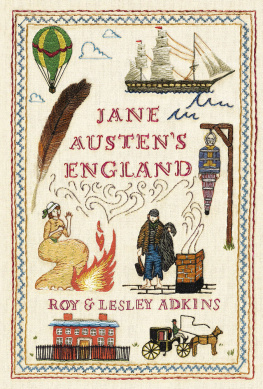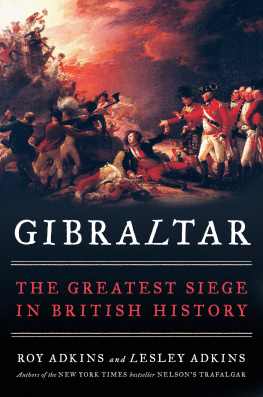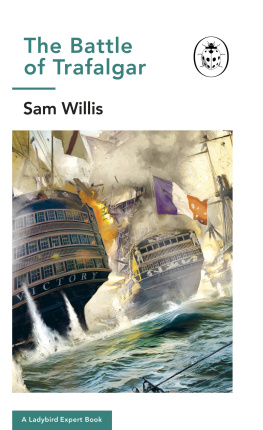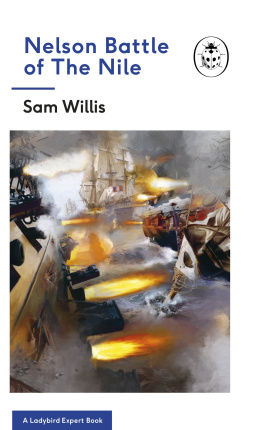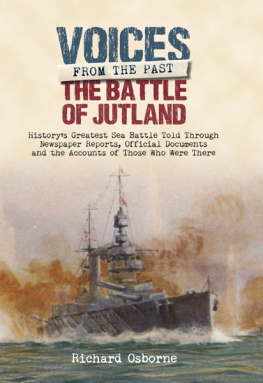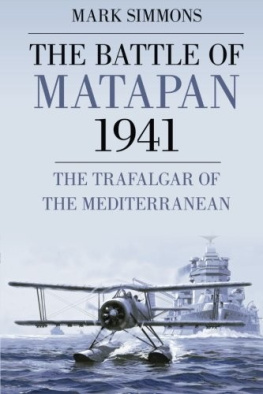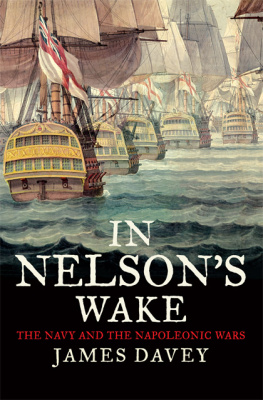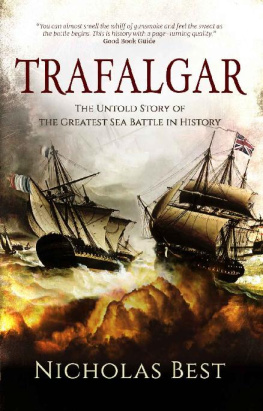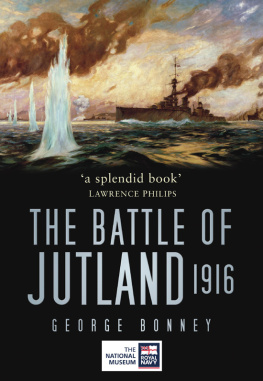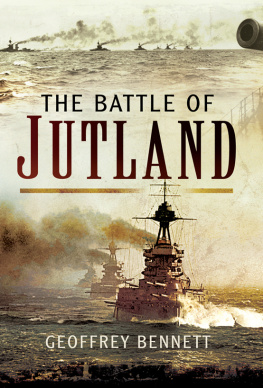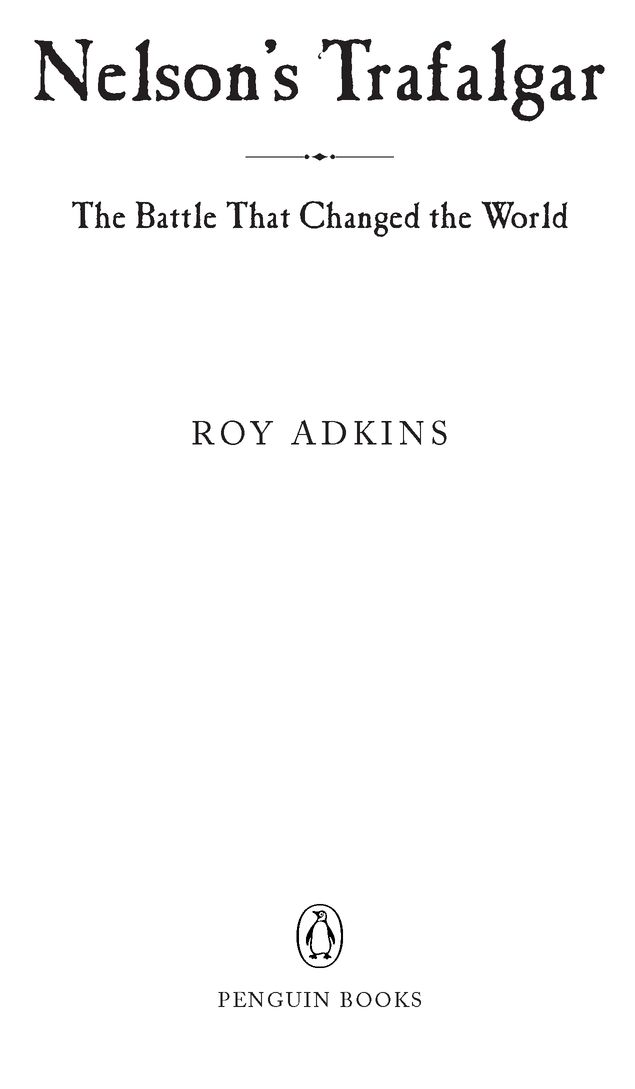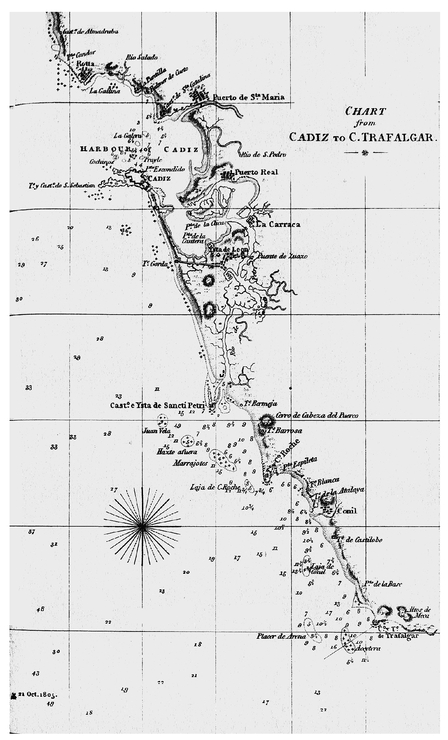Table of Contents
Praise for Nelsons Trafalgar
Captures the din, confusion, and sheer carnage of the battle. Mr. Adkins reminds us that in the cramped gun decks the noise of the battle could be felt as much as heard: a maddening sensation of pressure on the skull.
The Wall Street Journal
This illustrious introduction to the Battle of Trafalgar from an archaeologist and historian is one of the best in generations for the nonseafaring reader curious about the nautical epic, and it also handsomely rewards those whose study of the battle goes back a generation or two.
Publishers Weekly (starred review)
Masterful
Bernard Cornwell, Mail on Sunday (London)
Vivid, scrupulous, immensely moving, this is a terrific yarn.
Christopher Hirst, The Independent (London)
ABOUT THE AUTHOR
Roy Adkins is a historian and archaeologist. He is also a Fellow of the Society of Antiquaries of London. His previous books include The Keys of Egypt: The Race to Crack the Hieroglyphic Code, Dictionary of Roman Religion, and Handbook to Life in Ancient Rome.
An 1805 chart, showing the treacherous shoals along the dangerous Spanish
coastline between Cadiz and Cape Trafalgar
To Lesley, for everything
MAPS AND PLANS
Frontispiece: An 1805 chart, showing the treacherous shoals along the dangerous Spanish coastline between Cadiz and Cape Trafalgar (The Naval Chronicle 14,
1805, opp. p. 416) v
Map of south-western coast of Spain xviii
Basic plan of a ship 55
Diagram of comparison of ship sizes 56
Diagram of aspects of sailing vessels 70
Plan of the opposing fleets at noon on 21 October 1805 102-3
Plan of the opening phase of the battle at 12.45 p.m. 118-19
Plan of the battle at 1.15 p.m. 148-9
Plan of the battle at 2 p.m. 174-5
Plan of the battle at 2.45 p.m. 182-3
Plan of the battle at 4.30 p.m. 208-9
1809 chart of Cadiz (The Naval Chronicle 21, 1809, opp. p. 476) 237
LIST OF ILLUSTRATIONS
FIRST INSERT
Page 1
Top: Rear Admiral Lord Nelson wearing all his decorations. (Naval Chronicle 3, 1800, opp. p. 167)
Bottom: Napoleon Bonaparte from a painting by Tallandier. (Giraudon/Bridgeman Art Library)
Page 2
Top: Sailors drinking grog. (The Log Book or Nautical Miscellany, p. 17)
Bottom: Ann Hopping. (Illustrated London News, 9 May 1863, p. 512)
Page 3
Top: Vice-Admiral Villeneuve. (Giraudon/Bridgeman Art Library)
Bottom: Vice-Admiral Lord Collingwood. (Naval Chronicle 15, 1806, opp. p. 353.)
Page 4
Top: Spanish Admiral Frederico Carlos Gravina. (Museo Naval de Madrid)
Bottom: Captain Don Cosm Churruca. (Museo Naval de Madrid)
Page 5
Top: Nelson and his officers aboard Victory. (National Maritime Museum)
Bottom: Nelson giving instructions before the battle. (National Maritime Museum)
Page 6
Top: The Combined French and Spanish Fleet in Cadiz harbour. (National Maritime Museum)
Bottom: A plan of the approach. (National Maritime Museum)
Page 7
Top: A cartoon of a British seaman. (National Maritime Museum)
Bottom, left: Captain Jean-Jacques-Etienne Lucas. (Getty Images)
Bottom, right: Dr. William Beatty. (National Maritime Museum)
Page 8
Top: Nelsons and Collingwoods columns. (National Maritime Museum)
Bottom: A view from the French and Spanish side. (National Maritime Museum)
SECOND INSERT
Page 1
Top: The battle at an early stage. (Allen, 1841, opp. p. 122)
Bottom, left: Captain Thomas Masterman Hardy. (National Maritime Museum)
Bottom, right: Captain Henry Blackwood. (National Maritime Museum)
Page 2
Top: George Duff. (Naval Chronicle 15, 1806, opp. p. 265)
Bottom: The shooting of Nelson. (Craik & Macfarlane, 1844, p. 192)
Page 3
Top: The battle at about two oclock. (Christies Images, London, UK: www.bridegman.co.uk/)
Bottom: The battle late in the afternoon. (Allen, 1841, opp. p. 146)
Page 4
Top: The Achille on fire. (National Maritime Museum)
Bottom: The scene towards the end of the battle. (National Maritime Museum)
Page 5
Top: Jeanette being rescued. (Bridgeman Art Library)
Bottom: A print of a woman with her child tending the wounded. (The Log Book or Nautical Miscellany, 1830, p. 33)
Page 6
Top: A print of a woman searching for her husband. (Glascock, 1835, frontispiece)
Bottom: The morning after the battle. (Naval Chronicle 15, 1806, opp. p. 36)
Page 7
Top: Captain John Richard Lapenotiere. (National Maritime Museum)
Bottom: Spanish sailors on the shore. (Palacio del Senado, Madrid)
Page 8
Top: Captain Thomas Normans gravestone. (Authors photo)
Bottom: The scene on 28 October. (National Maritime Museum)
INTRODUCTION
LEARNING THE ROPES
Britain is an island, with no place more than 70 miles from the coast. Its great seafaring tradition, based on fishing and trade, both coastal and international, mainly had an impact on seaside communities, yet during the wars with France in the eighteenth and nineteenth centuries, seamen were taken as volunteers or by the press-gangs from almost every part of the country. Those who returned after years at sea brought with them a rich vocabulary of nautical words and phrases, drawn not from the merchant marine, but from the Royal Navy. Many of these words and phrases, such as swinging the lead and groggy, still retain the meanings they had in Nelsons day, while others such as junk and nipper have subtly changed over the centuries. In this book, any nautical terms that are essential for understanding the story are explained at the point where they first occur. For anyone who wants to find out the precise meanings of the nautical terms of the period, the first port of call is A Sea of Words by Dean King, which covers all the most common words and expressions.
As in all battles, the eyewitnesses at Trafalgar did not record minute-by-minute details during the fighting, but set down what they remembered afterwards. Together with the confusion of the battle and the fact that no one could see more than a small part of the action, this led to large differences between individual accounts. The greatest discrepancies are in the precise times of the various incidents, where records may differ not just by minutes but by hours. In this book the sequence and timing of events have been based on the exhaustive analysis of Rear-Admiral A. H. Taylor in his 1950 article in the Mariners Mirror.
Another potential source of confusion is the fact that some British ships had French-sounding names (such as the Entreprenante), and some French ships had British-sounding names (such as the


